He [Brahman] became like unto every form, and this is meant to reveal the true form of him [the Atman]. Indra [the Lord] appears multiform through the Mayas [appearances], for his horses are yoked, hundreds and ten.
This [Atman] is the horses, this [Atman] is the ten, and the thousands, many and endless. This is the Brahman, omnipresent and omniscient. This is the teaching [of the Upanishads].
Brhadaranyaka Upanishad
I Adhyaya, 5 Brahmana, 19

There are many books which cover the parallels between the new physics and mysticism, but few help us to actually visualize what this great integration means to our worldview. Surprisingly enough, there is an easy way to quickly integrate the ancient mystical connections into our current worldview, although it seems so bizarre to our normal 'common sense' way of looking at things that it is not as easy to assimilate as it is to say. A basic understanding of the new vision of reality provided for us by modern physics will help it to seem less unbelievable, as does a familiarity of the ancient schools of sacred geometry. It basically comes down to a matter of perspective, and requires a totally new understanding of space and time -- new at least for most of us in the West.
A Matter of Perspective
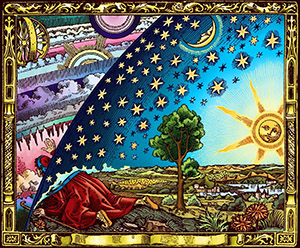
From where we are now, we look out upon an apparently expanding Universe. We project this image back in time, way back in time, almost 14 billion years, toward that singular point of origin called the Big Bang. This Universal Singularity is thought of as infinitely dense, our entire Universe compressed to a single point, where the laws of physics do not apply -- infinitely dense matterenergy and no spacetime. (Actually, physics breaks down at the Planck time, before reaching the Singularity itself.) The concept of the Big Bang represents a singular point of origin for our entire Universe, a state of pure and infinite potential, and the whys and wherefores of the origin of that state completely transcend spacetime and are beyond the scope of physics. Modern cosmology and common logic tells us that this is a past state of the Universe which has since evolved into what we see now, so we tend to think of it as no longer existing as such. Now, imagine that this is not exactly the full picture.
Imagine that what we have conceptualized as the Singularity of the Big Bang does still exist in that initial state of pure potential, right at this moment -- we see it on the one hand (in a fragmented way) as the singularities of particles, every particle in the universe, and see it on the other hand (in a reversed way) as the infinity of space.
Now forget the idea that atoms are even particles at all. Think of atoms as four-dimensional vortices of past spacetime that reach all the way back to the Singularity of the Big Bang, which is still there shining forth as it always has, providing the very substance of every "wherewhen of spacetime" that ever was or will be. Of course, our surface consciousness of the physical world 'floats' in the resonant state called the present, where we see only the top cross-sectional ring of each vortex (more like interacting sets of vortices), which appear to us as those strange tiny spheres called atoms. In a sense, we could say that the center of every atom is in the same place -- and even more strange, this very same place is also seen as the infinity of space.
In this perspective, the Big Bang is not merely an event in the past which created matterenergy in spacetime (although this is still true from within our normal perspective on time), but is more precisely a continuous state which creates what we experience as matterenergy in spacetime -- the Big Bang is more like a Big Shine. In the light of what we know today about matterenergy in spacetime, such a view is not really that far out at all. Modern physics knows that the quantum processes which form the substance of all matter completely ignore the rules of spacetime separation, and are actually manifestations of interacting force fields which are in turn aspects of a single universal Superforce.
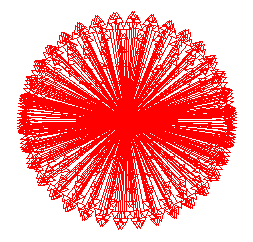
This worldview sees every quantum process of the Universe -- past, present, and future -- as integral an part of a timeless state of the Universe that is equivalent to the Planck-time of Big Bang cosmology. We can conceptualize this state as a hyperspherical condition of unified force, expressed as a polarity between the Universal Singularity and a higher-dimensional Infinity -- a hyperspherical polarity conceptualized as the Universal Hyperspherical Polarity.
The polarity between the Universal Singularity and the higher-dimensional Infinity manifests in our experience in a number of lower-dimensional forms, and is key to understanding our experience of time, space, consciousness, and how the entire Universe is tied together in our experience of matterenergy in spacetime.
In a manner of speaking, the Hyperspherical Polarity is 'sliced up' into our experience of four-dimensional spacetime. As space itself, it is the polarity between every single dimensionless point in space and the fully-extended three-dimensional infinity outward from that point. As time itself, it is the polarity between the singularity of past and the infinity of future, between the singular course of deterministic events which led to the present moment and the infinite number of possible and somewhat predeterministic futures. In individual consciousness it emerges as the polarity between the singular localized reference frame and the infinite field of matterenergy in spacetime surrounding the experiencer. In matterenergy, the polarity appears in the dualistic nature of quanta, which act as either localized point particles or as expanding wavefronts.
Reality divided by reason always leaves a remainder. After everything has been said about the universe, after the entire world has been transformed on the basis of scientific knowledge into a hierarchical structure of ever-widening systems, we are still left with a profound sense of mystery. ...
This luminous experience of the impenetrable mystery is common to all the scientists, philosophers, and mystics of the highest rank. The scientist calls it the mystery of Nature. The philosopher calls it the mystery of Being. The mystic calls it the mystery of the Spirit.
Haridas Chaudhuri
Being, Evolution, and Immortality
1974, The Theosophical Publishing House
The Geometry of Nondualism
Tibetan Mysticism is probably the best preserved system of teaching for Advaita Vedanta. It teaches that the polarity of time arises from the experience of the polarity of consciousness. This also manifests as the polarity between subject and object, between consciousness and spacetime. Akasha, the field of spacetime, arises as an external experience of our innermost level of being, a ray of Prana, the Universal Lifeforce.
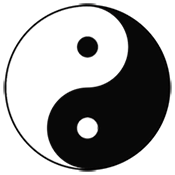
At the root of the geometry of Nondualism is the phenomenon of polarity. Basically, it is a single reality with two polar opposite aspects. Like the concept of force, it is a very ethereal reality; that is, it has no tangible physical reality that can be seen or touched, but it can have a very real effect on the physical world. That effect can indeed be seen, felt, or otherwise experienced.
Polarity can be represented by a vector, which is represented by an arrow. A vector is a simple line segment with an arrowhead on one end, indicating that one end is the opposite of the other, or that it has a directional quality. It can have a specific length, representing the magnitude of a force, for example, but when used to represent the concept of polarity itself, the vector’s length is arbitrary and meaningless.
Polarity can also be represented by a plane perpendicular to the vector. The plane is a single reality with two sides, one opposite the other. The plane of polarity and the perpendicular vector are complementary aspects representing the concept of polarity. Either or both can be used to represent the ethereal reality of polarity.
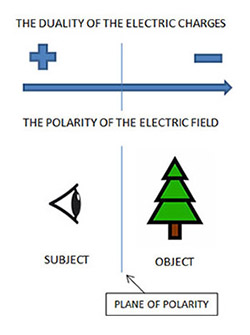
What is most important to understand about polarity is that it is a unifying principle. In physics and metaphysics both, the polarity underlying a duality is the most real level of reality – the polarity is there first, so to speak, and the separateness of the duality is a physical-level experience of that polarity.
The eye in the illustration representing the subject should not be thought of as a physical eye, but rather as our third eye, the ‘eye of the soul’, the experiencer, the true self. The physical eye, along with the entire physical body, is actually on the objective side of the polarity. The body should be recognized as object in the same way that the entire physical body lays upon the surface of the past light-cone in the spacetime diagram. The subject part of the spacetime diagram, the observer, is represented by the singularity at the tip of the light-cone.
Time is our most fundamental experience of a polarity. The opposite sides are past and future, and the plane of polarity between these two fields is the ever-changing present. This is a good example of polarity not only unifying two poles but also unifying a three-fold experience. This is a very important point – the three-fold time experience is a direct expression of the Universal Trikaya. The single state of polarity with a two-fold reality that results in a three-fold experience is key to how the One Reality builds Creation.
The language of Sanskrit has two different words for the infinity of space. There is the word akasha, the experiential space of individual consciousness already introduced, and there is the word Tamas, referring to what would be conceptually understood to be a true absolute void. Akasha, recall, is not an absolute void. It is a space filled with force vectors manifesting as matterenergy in spacetime as well as the apparent void between matter, in the same way that quanta create matter and energy as well as the quantum foam that fills all of ‘empty’ space.
The infinity of Tamas, on the other hand, is the experience of emptiness from the perspective of Universal Consciousness and is indeed an absolute void. It is an absolute void by definition, because from the perspective of all that is, the only sense of otherness is an absolute void. It is important to note that Tamas is not something that exists independently of Universal Consciousness. It is not really there independent of Universal Consciousness in the same way that no void actually existed for the Big Bang to expand into. According to the physics of Big Bang cosmology, there is no space or time whatsoever at time=0.
An excellent meditation exercise in Jnana Yoga is to visualize your innermost reality as a pin-point of white light force which has its polar opposite reflected directly as the experience of the blackness of infinity around you. In fact, individual consciousness has a depth of extension equal to that of the Universe itself. As incredible as this may seem, it is a metaphysical reality -- the depth of space is a direct reflection of the magnitude of consciousness.
You can think of depth-consciousness as like viewing a line (or vector) end-on, looking like a singularity, or, perhaps more mind-blowing, you can think of the depth of space as being not nearly as huge as it appears. Either way is as correct as the other. However, what is most accurate is to realize that any idea or experience of depth of extension in physical space is illusory, but is rather an experience of the force of consciousness. In Reality, there is no space between anything. The experience of space and separateness is merely the external expression of the force of consciousness, the only real Reality there is.
If there were no objects, there would be no subjects; and if there were no subjects, there would be no objects. For on either side alone nothing could be achieved. But that (the self of pragna, consciousness, and prana, life) is not many, (but one). For as in a cart the circumference of a wheel is placed on the spokes, and the spokes on the nave, thus are these objects (circumference) placed on the subjects (spokes), and the subjects on the prana. And that prana (breath, the living and breathing power) indeed is the self of pragna (the self-conscious self), blessed, imperishable, immortal.
Kausitaki-Brahmana Upanishad
III Adhyaya, 8
Geometrically, the polarity between consciousness and spacetime can be recognized as a spherical polarity. Whereas a single vector can represent a linear polarity, a spherical polarity must be represented by an infinite number of vectors. Geometrically, and as introduced earlier, a spherical polarity is the polarity between a single point, or singularity, and the infinity around that point, represented by a spherical array of vectors radiating in all directions from the singularity. A spherical array in a higher dimension is called a hyperspherical array. With this in mind, we can go back to the hyperspherical model of the One Reality and introduce some of the specific features of this geometric picture of Nondualism.
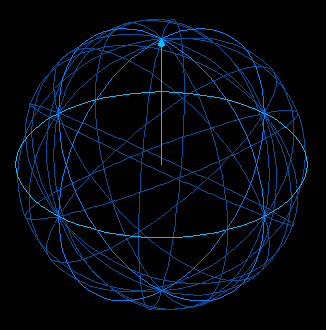
A hyperspherical force polarity, a Universal Hypersphere through the interaction of the infinite number of ring-ray elements, and with any one of those elements serving as a reference, or seed of consciousness, can act as a Fourier Series generator, the geometric equivalent to an infinite and superimposed series of harmonic oscillators.
This provides a geometric source for the wave mechanics of matterenergy in spacetime, while maintaining an underlying level of all possible realities in an unmanifest state. Many will recognize the key significance of this to the wavefunction of quantum physics and in the way matter and energy seem to behave.
This geometric model of unified field physics provides a mechanism for the seemingly strange properties of both Relativity and quantum physics, including the light-cone, the wave-particle duality, the wavefunction, quantum entanglement, the quantum foam of empty space, and 'vibrating strings'. Even the red-shift of the galaxies and the cosmic microwave background radiation, key indicators for an apparently expanding universe with a Universal Singularity as an origin, could be understood to be the result of the overall spherical curvature of space, caused by the omnipresent hypersphere of the Universal Superforce. From the perspective of the timeless Universal Hypersphere, the physical expansion of the Universe is illusory.
The geometry can also represent such metaphysical principles as the male and female movements of Creation and the polarity of time and consciousness. Perhaps most interesting, it can also beautifully represent the nature of the Trikaya, the three-bodied unfoldment of Creation from the One Reality. The central singularity is the first body of the Trikaya, the ‘shining forth’ of the infinite vectors of its creative expression is the second body, with the ‘cosmic dance’ of the Universe itself being the third.
Note that a ring on a four-dimensional hypersphere appears as a sphere in three-dimensional space. The more the ring is rotated away from the reference ring, the farther away it appears in 3D space, with a 90-degree rotation representing infinity.
Any one ring on the hypersphere is more properly thought of as an infinite number of rays itself, but only those limited to that single plane sliced from the hypersphere. That ring of rays, of course, appears as a spherical array of infinite rays in three-dimensional space. Within our limited space of experience, it is the perfect image of, and still an integral part of, the Universal hypersphere.
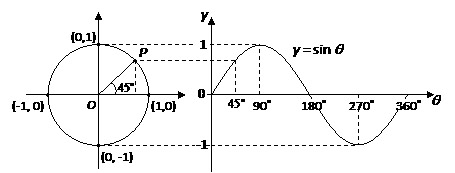
A harmonic function is a waveform that repeats itself. A simple harmonic function, such as a sine wave (or cosine wave), can be generated by a rotating vector, like the hand on a clock. A Fourier Series is the sum of an infinite number of simple harmonic functions of varying frequency and amplitude, creating even the most complex periodic wave form, including the wavefunctions which define quanta.
In this way, the entire Universe can be represented by the combination of an infinite number of sinusoidal harmonic functions. There are an infinite number of rings on the hypersphere existing at every imaginable angle, providing an infinite number of harmonic functions which can define an infinite number of complex waveforms. Even a square wave, another example of a simple harmonic function, can be represented by the sum of an infinite series of varying sine waves.
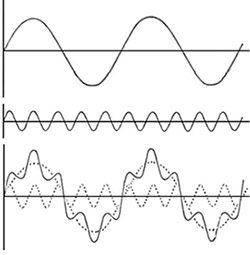
The importance of harmonic functions and the mathematical and geometric concept of the Fourier Series began to come to light in 1865 when James Clerk Maxwell unified electricity and magnetism into the electromagnetic field. This was the first great unification in physics since Newton unified gravity and astronomy nearly 200 years earlier and was a huge step forward in our understanding of the physical world, essentially as much as was Einstein’s geometric formulation of gravity in his theory of General Relativity 50 years later. The electromagnetic field defines everything we see and physically feel, including the dynamics of the electron layer of the atom and all of chemistry, and it is all based on harmonic functions.
A complete Unified Theory of the Universe was Einstein’s dream and he spent his later years working on it. By 1979, the unification of the electromagnetic force field and one of the nuclear forces was formalized, becoming the basis for a Grand Unified Theory which unifies all the forces of the Universe except for gravity. The Kaluza-Klein model, with its five-dimensional spacetime, unifies Maxwell’s equations with Einstein’s equations. Essentially, the electromagnetic field and the gravitational field become unified in a beautiful symmetry.
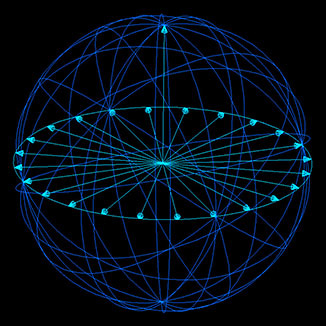
With this geometry representing the quantum realm in its most fundamental form, it can be thought of as forming the central reality of any of the current unified field models, including string theory. It is interesting to note that a four-dimensional hypersphere could be a ring on a five-dimensional hypersphere, which could be a ring on a six-dimensional hypersphere, and so on, each representing a new set of infinite possibilities, and all centered on the same singularity.
The Universal Hypersphere could be thought of as a geometric version of the Wavefunction of the Universe, introduced by Hugh Everett in 1956 in a thesis draft and written up by James Hartle and Stephen Hawking in the Physical Review in 1983. (It is actually an idealized mathematical expression, using an infinite series of harmonic oscillators, but it does have applications in quantum cosmology.)
The wave function of the Universe … is essentially a list of all possible histories … through which the Universe could have evolved to its present quantum state, which itself includes all logically possible particles and arrangements of particles that could exist in the Universe at the present time.
John D. Barrow and Frank J. Tipler
The Anthropic Cosmological Principle
1986, Oxford University Press
An important philosophical feature of quantum physics is revealed by the wavefunction and the non-deterministic nature of quantum measurement. Quantum indeterminism, along with the underlying level of all possible realities, is directly tied to our experience of free will. In this way, quantum physics actually negates the philosophical problem of the existence of free will in our apparently deterministic Universe.
It is also interesting to note that a four-dimensional hypersphere could be a ring on a five-dimensional hypersphere, which could be a ring on a six-dimensional hypersphere, and so on, each representing a new set of infinite possibilities, and all centered on the same Universal Singularity.
Even though the idea of rings on a hypersphere is useful in representing matterenergy in spacetime and individual consciousness, the primary reality of the hypersphere is not really a sphere with a surface full of rings as such. This view only comes into play during the experience of time and individual consciousness. The ultimate reality of the hypersphere, rather, is defined by a spherical array of vectors in a higher dimension, infinite in number and infinite in length. The idea of a hyperspherical force polarity is fundamental and remains unchanged during the experience of any spacetime unfoldment.
The geometric connection between the Superforce of unified field physics and the Nondualism of the Ancient Wisdom can only be understood if spiritual reality is expressed in the nontheistic terms of metaphysics. It is important to recognize that Advaita Vedanta, Gnosticism, and Kabbalah, etc., are not the only traditions with a metaphysical understanding of the One Reality.
An Interpretation of Modern Physics
The concept of a Universal Hypersphere would be a geometric expression of Logos, the transcendental First Cause of Creation, and the central singularity would represent Mythos, the fully transcendental essence of Existence itself. It would thus be the metaphysical seed of Sacred Geometry, which is the emergence of individual consciousness and the experience of Creation. It would also provide a geometric model of today’s unified field physics, along with the strange implications, while incorporating human consciousness into the picture.
The seed-ray represents the source of individual consciousness and the experience of time. Being a fully integral part of the hypersphere, it has no reality independent of the hypersphere. With its complementary ring-aspect, it forms the geometric foundation of the light-cone. From our spacetime perspective, that ring at the base of the light-cone is experienced as the infinity of space, and everything in between is defined by the surface of the light-cone itself.
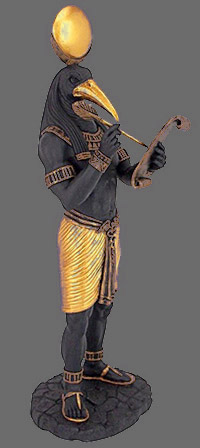
The actual quantum reality underlying any atom, or even any point in empty space, is defined by the other ray-ring elements on the hypersphere, which in fact are still in their higher-dimensional state of unity while only appearing to be 'out there' in space. The intricate web of akasha creates the entire experience of matterenergy in spacetime, including the Planck-scale spheres of pure potential which fill the quantum vacuum. The hypersphere itself represents all possible realities, including the parallel universes often used to explain the probabilistic nature of the quantum world, and which need not be considered as actually being in a manifested form to be part of the quantum description.
The point, of course, is to realize that even in the physical world of separateness the primary source of everything is still the transcendental state of wholeness. This state of the Universe is the driving force of our life and consciousness this very moment, and at the same time, it is the source of literally everything else in our world. The Light of transcendental omnipresence never changes, and by that right, it is the most real state of Reality we can possibly imagine. "There is only That; We are That"; always have been, always will be.
With the ancient understanding of space, time, and consciousness firmly in mind, we can look at the hypersphere of the Big Bang in a new light. From a mystical perspective, the Big Bang of modern cosmology is a continuous process, an omnipresent condition which has always been the same no matter what we believed. Western science, caught up in its purely objective view of existence, has imposed the concept of 'universal time' on this timeless condition, projecting it into the past as a single event.
What a strange thing to do with the most beautiful mystical principle of all. We have completely ignored the ancient message of nondualistic mysticism and have thus found our science of the universe bogged down in the "strangenesses" of relativity and quantum theory for most of this century. We have certainly developed an extraordinary understanding of the physical universe, and this was no doubt the purpose of modern science, but perhaps now is a good time to re-integrate the sacred science of the ancients.
Anyone who has experienced an actual mystical realization of oneness will tell you that if we were not transcendentally unified, we would not even be here. Of course, that is a subjective experience and belief and, like someone who has had a near-death experiences, the effect on awareness and overall worldview is very difficult to share with anyone else in a convincing way.
Science does not need a transcendental oneness to do objective modeling of the Universe, but without it, we are left with the very bizarre observations of Relativity and quantum physics, and the great mysteries of the Universal Singularity of Big Bang cosmology and the Universal Superforce of unified field physics remain largely uninterpreted.
It is clear that our understanding of the Universe has grown exponentially over the ages, and to now find ourselves at a point where scientific physics clearly offers a worldview consistent with the Ancient Wisdom is remarkable and exciting. There is no doubt that this is an important step in the evolution of human awareness.
The integration of physical knowledge and spiritual understanding is a key part of the awakening process that our planet is experiencing today. It will obviously involve a fundamental paradigm shift in our objective understanding of space, time, and matter. This paradigm shift began earlier this century with the birth of both Relativity and quantum theory. These scientific theories deal with universal principles, and being firmly based in the objective logic of the scientific method, their revelations have emerged in the form of the very strange concepts deeply embedded within Relativity and quantum physics.
Only when we fully integrate mystical knowledge into our worldview do the strange implications of modern science begin to make sense. At the same time, the language of modern science becomes a great help in understanding what the Ancient Wisdom is all about.
Human consciousness has indeed come full circle. We have arrived where we started in the sense that an ancient understanding has once again been brought to light. At the same time, we have taken a quantum leap forward in the evolution of human awareness.
The Brahman which has been thus described
is the same as the akasha which is around us [the physical forces];
And the akasha which is around us,
is the same as the akasha which is within us [Lifeforce].
And the akasha which is within us,
That is the akasha within the heart [the soul].
That akasha in the heart is omnipresent and unchanging.
He who knows this obtains omnipresent and unchangeable happiness.
Khandogya Upanishad



